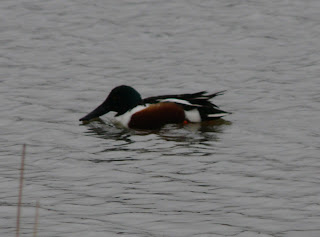Without being too personal that certainly is one almighty beak! That said, it is a really effective feeding tool. The shoveler (Anas clypeata) does what it says on its label, shovelling its food up by taking in large amounts of water and filtering it out through the sides of that large beak and digesting what is left. Often, you will see little lines of them with the leader disturbing the water and the ones behind in its 'slip stream' benefiting from the stirred up water. From a distance their mainly white colouring with rusty sides usually make them clearly identifiable.
Although a breeding species in south eastern England the shoveler is not known as a breeding species here in Dorset; there may be occasional successful broods but as I understand it shoveler breeding in Dorset is a rare occurrence. The shoveler is also migratory and British birds tend to head south into southern Europe and north Africa once breeding is over. Despite this, you will see shoveler in suitable locations in Dorset for much of the year because in winter birds from northern Europe arrive here and replace those that left us. It gives the impression that the shoveler is a resident species but it is a trick of the light!
The weekly reporting chart of tweets shows continual records of shoveler from week 34 in mid-August right through the winter until week 21 in the following May. Between week 22 and week 33 reports are less frequent but it does show that shoveler are here abouts during the summer even if they are not breeding. Certainly, it seems the bulk of the Dorset birds are incoming winter migrants with numbers much higher after the turn of the year until April than during the rest of the year.
There are reports of shoveler from twenty five Dorset locations to date with Poole Harbour sites in particular being popular. The shoveler likes shallow open water around saltmarsh and this habitat is common at the western end of Poole Harbour as it is too in Christchurch Harbour where shovelers are also frequently seem. The Fleet suits shoveler as does Radipole Lake and Lodmoor. They also occur inland at large lakes such as at Longham and West Moors.
Any sheltered coastal habitat in winter is likely to produce shoveler for the Dorset list accumulator.

Comments
Post a Comment